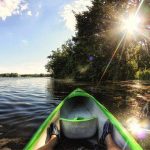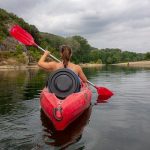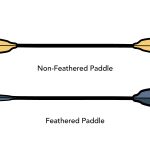What’s the best kayak for me? That’s the first question a kayaker asks themselves, and it’s often the hardest one to answer. You need to find a kayak that meets your needs and values, and that can be a challenge.
Kayak Type
There are many kayak companies and models to choose from, so you can find the perfect one for your style of paddling and needs. To start, think about what type of kayaking you enjoy and how that could change in the future. Look at resources like the Paddling Buyer’s Guide to narrow down your choices.
The type of kayak you want depends on where you want to paddle and what activities you want to do in your kayak. For example, if you want to paddle in open water and exposed shorelines, you should look at touring kayaks, which are longer and more seaworthy.
However, touring kayaks require training and stronger skills to paddle. If you want to paddle in more mellow conditions, you will likely appreciate the stability and comfort of a recreational kayak.
Sit-on-tops are a type of kayak that doesn’t have a confining deck and are good for casual paddling in warm water locations, as well as kayak fishing.
There are many different variations of kayaks designed for specific water conditions, trip lengths, and activities. There are options within some of these categories you’ll need to consider. For example, do you want a kayak for two people?
Is a sit-inside or sit-on-top kayak better for your pursuits? Should you go with a hard-shell vessel or inflatable?
Here’s an overview of the various types of kayaks:
Recreational Kayaks
Recreational kayaks are good for people who spend most of their time on lakes and slow-moving rivers. They typically have a flatter hull and are wider than most touring kayaks, giving them more stability.
However, the extra width also means they will drag more in the water and wind, making them a little slower than some other types of kayaks. Recreational kayaks are usually 10 to 12 feet in length, which may mean they can turn better but won’t track (the tendency of the kayak to travel in a straight line) as well as a longer design.
Touring and Sea Kayaks
Touring and sea kayaks are typically 14 to 18 feet long, which makes them longer than most other types of kayaks. These boats have a long waterline, making them easier to track; however, this also makes them more difficult to turn.
Their length also allows for ample storage space for overnight or multi-day trips. Touring kayaks are also generally narrower and sit lower in the water, which allows for greater speed and efficiency as the kayak cuts easily through wind and water.
The narrower profile of touring and sea kayaks means these boats will feel less stable for beginners than recreational kayaks.
Fishing Kayaks
Fishing kayaks are built to be stable and durable, rather than fast. They often have a lot of storage space for fishing tackle and gear, as well as features such as rod holders, mounting brackets, bottle holders, and anchor lines.
Some kayaks have pedal-drive systems or trolling motor mounts so that anglers can reach the fishing grounds more quickly.
Whitewater Kayaks
Whitewater kayaks are shorter and have more curves than other kayaks, which allows them to turn more easily. They aren’t very good at going in a straight line, and they don’t have much storage space. They are designed specifically for paddling in whitewater.
Crossover kayaks are a type of whitewater kayak that performs better on flat water, making them more versatile.
Single or Solo Kayaks
A single kayak is a water vessel that is designed to only hold one person. There are different types of single kayaks for different purposes such as whitewater, recreation, and fishing.
Double or Tandem Kayaks
Some kayaks can be paddled solo or with another person, depending on the design of the seats. Tandem kayaks are made specifically for two people to paddle together, and can be used for activities such as fishing, touring, or whitewater kayaking.
Pedal-Drive Kayaks
A pedal-drive kayak is a sit-on-top kayak with pedals that move fins or a propeller attached through the hull of the kayak, used for fishing or taking photos. There is also a rudder to steer the vessel.
Pedal kayaks have reduced clearance, meaning you won’t be able to get into shallow water the same way you could in a paddle kayak.
However, they are fast and efficient as they make use of the powerful muscles of the legs; pedal kayaks are also more intuitive for beginner kayakers since you don’t need to learn various paddle strokes to control and propel the boat.
Sit-Inside Kayaks
Sit-inside kayaks are the best type of kayak to use if you want to be protected from the weather and water, especially if you’re kayaking in a colder climate or on an exposed coastline.
They also tend to be lighter than other types of kayaks and have more dry storage space inside them.
Sit-On-Top Kayaks
Sit-on-top kayaks have an open deck, making it easy to get on and off. They are also usually more stable than sit-inside kayaks.
Inflatable and Folding Kayaks
There is a wide range of inflatable and foldable kayaks available, which are suitable for everything from gentle pond paddling to extreme expeditions. These kayaks are light and easy to store and transport.
Hard-Shell or Rigid Kayaks
Hard-shell kayaks have many advantages over inflatable kayaks, but they are more difficult to store and transport. Hard-shell kayaks are faster in the water and better able to handle windy and wavy conditions.
How We Evaluated These Kayaks
Below are my recommendations for the best kayaks, based on my own personal experience as well as input from industry experts. I gathered information from sources such as Paddling.com and Paddling Magazine, and surveyed popular kayaking forums for customer feedback.
In order to narrow down the options, I considered factors such as the quality, durability, ease of use, customer support offered by the manufacturer, and value for money.
Best Kayaks
Wilderness Systems Pungo 120
Pros:
- Stable
- Agile
Cons:
- Larger paddlers might be cramped
Key Specs
- Type: Recreational
- Length: 12 ft. 2 in.
- Capacity: 325 lb.
The Wilderness Systems Pungo 120 is a modern, practical recreation kayak that paddles fast, straight, and smoothly. It is also stable in slightly choppy conditions. The seat is adjustable, comfortable, and has a mesh panel to help paddlers stay cool in hot or humid conditions.
The kayak also has a dry hatch at the stern, a removable dry box, cup holders, and a place to add an external battery for charging devices.
Wilderness Systems Tarpon 105
Pros:
- Very stable
- Comfortable
Cons:
- Slower to paddle
Key Specs:
- Type: Recreational
- Length: 10 ft. 6 in.
- Capacity: 325 lb.
Sit-on-top kayaks are a good choice for new paddlers since they are more stable. The Wilderness Systems Tarpon 105 has beginner-friendly features and is good for performance. It paddles straight and efficiently.
There are storage compartments, bungee straps, and accessory areas throughout the kayak. Plus, the adjustable seat is more comfortable.
Perception Tribe 13.5 Tandem
Pros:
- Stable
- Comfortable foot rests
Cons:
- Lacks waterproof storage area
- At 79 pounds, heavy to transport
Key Specs:
- Type: Recreational sit-on-top
- Length: 13 ft. 6 in.
- Capacity: 300 lb.
The Perception Tribe 13.5 kayak is ideal for flatwater paddling if you will be paddling with a partner. This sit-on-top kayak has adjustable framed seats and staggered footrests, making it more comfortable than standard sit-on-top models.
It is also stable, easy to maneuver, and has scupper holes to keep water from pooling in the seat areas. There is enough room to bring along day trip supplies with three bungee-secured stowage sections and two small sealed (but not waterproof) storage compartments.
Old Town Loon 106 Angler
Pros:
- Ultra comfortable
- Stable
Cons:
- Struggles in wind and chop
Key Specs:
- Type: Fishing
- Length: 10 ft. 6 in.
- Capacity: 325 lb.
The Loon 106 Angler kayak from Old Town is designed for comfort and practicality, with a supportive seat and extra padding around the cockpit. It also includes two-rod holders, an anchor point, a storage compartment, and bungee straps to secure tackle.
Although fishing is an ideal offline activity, this kayak comes with a work deck complete with a USB port and battery compartment—perfect for charging a phone or action camera.
Intex Explorer K2 Kayak
Pros:
- Low price point
- Easy to enter from the water
Cons:
- Paddles slow
Key Specs:
- Type: Inflatable
- Length: 10 ft. 3 in.
- Capacity: 400 lb.
The Intex Explorer K2 might not be the speediest kayak in the water, but it’s still enjoyable to paddle. It’s a great option for paddlers who have restricted storage space and are on a budget. It can also serve as a good backup kayak for road trips.
The kayak can be folded into a carrying bag and inflated within a few minutes if you have an electric pump (the included hand pump can be awkward to use). A removable skeg assists the boat in staying on course, and it comfortably accommodates an additional paddler or pup.
Old Town Castine 135
Pros:
- Tracks straight
- Agile
Cons:
- Struggles in choppy water
Key Specs:
- Type: Touring
- Length: 13 ft. 6 in.
- Capacity: 300 lb.
This kayak is designed for people who want the performance of a larger touring kayak, but with more agility. It has two storage compartments (one in the front, one in the back), bungee cords across the deck, and a padded seat with adjustable foot rests. You can also add a rudder (sold separately) to make it easier to steer.
Hobie Mirage Passport 12.0
Pros:
- Arms-free kayak experience
- Easy to use
Cons:
- At 73 pounds, heavy to transport
Key Specs:
- Type: Pedal
- Length: 12 ft.
- Capacity: 400 lb.
Kayaks that are powered by pedals are a good workout for your legs and are popular with anglers. The Mirage Passport 12.0 comes with a paddle, storage areas, rod holders, and anchor mounts.
Bote Deus Aero 11-Foot Inflatable Kayak
Pros:
- Two-year warranty
- Multiuse watercraft
Cons:
- Backrest can feel unstable
Key Specs:
- Type: Inflatable
- Length: 12 ft. 6 in.
- Capacity: 300 lb.
The Deus Aero can be used as a standup paddleboard or sit-on-top kayak, and it is recommended that you use an electric air pump to inflate it. It is great for a casual cruise in calm conditions, and the two-in-one design saves you storage space and money.
The flat back deck makes it easy to climb back onto if you tip into the water.
Oru Beach LT
Pros:
- Portable
- Easy to assemble
Cons:
- Carry case sold separately
- The open cockpit makes it a challenge to deal with when it takes on water
Key Specs:
- Type: Foldable sit-in
- Length: 12 ft.
- Capacity: 300 lb.
Ching together flexible sheets of plastic, the Oru Beach LT sit-in kayak rapidly increases in popularity among portable kayaks. It takes five minutes to assemble, though this may take a few attempts to perfect. The kayak can carry up to 300 pounds and has ample space for storing supplies on day trips in calm waters.



